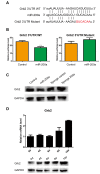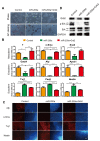MicroRNA-200a regulates Grb2 and suppresses differentiation of mouse embryonic stem cells into endoderm and mesoderm
- PMID: 23874841
- PMCID: PMC3715486
- DOI: 10.1371/journal.pone.0068990
MicroRNA-200a regulates Grb2 and suppresses differentiation of mouse embryonic stem cells into endoderm and mesoderm
Abstract
The mechanisms by which microRNAs (miRNAs) affect cell fate decisions remain poorly understood. Herein, we report that miR-200a can suppress the differentiation of mouse embryonic stem (ES) cells into endoderm and mesoderm. Interestingly, miR-200a directly targets growth factor receptor-bound protein 2 (Grb2), which is a key adaptor in the Erk signaling pathway. Furthermore, high levels of miR-200a dramatically decrease Grb2 levels and suppress the appearance of mesoderm and endoderm lineages in embryoid body formation, as well as suppressing the activation of Erk. Finally, Grb2 supplementation significantly rescues the miR-200a-induced layer-formation bias and the Erk suppression. Collectively, our results demonstrate that miR-200a plays critical roles in ES cell lineage commitment by directly regulating Grb2 expression and Erk signaling.
Conflict of interest statement
Figures




Similar articles
-
Ectopic expression of GATA6 bypasses requirement for Grb2 in primitive endoderm formation.Dev Dyn. 2011 Mar;240(3):566-76. doi: 10.1002/dvdy.22447. Epub 2010 Oct 5. Dev Dyn. 2011. PMID: 20925113 Free PMC article.
-
Progesterone signaling/miR-200a/zeb2 axis regulates self-renewal of mouse embryonic stem cells.Biomed Pharmacother. 2014 Mar;68(2):201-8. doi: 10.1016/j.biopha.2013.12.006. Epub 2013 Dec 24. Biomed Pharmacother. 2014. PMID: 24433831
-
Regulated Nodal signaling promotes differentiation of the definitive endoderm and mesoderm from ES cells.J Cell Sci. 2007 Jun 15;120(Pt 12):2078-90. doi: 10.1242/jcs.004127. Epub 2007 May 29. J Cell Sci. 2007. PMID: 17535850
-
The Expression and Functional Roles of miRNAs in Embryonic and Lineage-Specific Stem Cells.Curr Stem Cell Res Ther. 2019;14(3):278-289. doi: 10.2174/1574888X14666190123162402. Curr Stem Cell Res Ther. 2019. PMID: 30674265 Review.
-
Differentiation of definitive endoderm from mouse embryonic stem cells.Results Probl Cell Differ. 2012;55:303-19. doi: 10.1007/978-3-642-30406-4_17. Results Probl Cell Differ. 2012. PMID: 22918814 Review.
Cited by
-
MicroRNA-124a inhibits endoderm lineage commitment by targeting Sox17 and Gata6 in mouse embryonic stem cells.Stem Cells. 2020 Apr;38(4):504-515. doi: 10.1002/stem.3136. Epub 2019 Dec 30. Stem Cells. 2020. PMID: 31828873 Free PMC article.
-
MicroRNAs-141 and 200a regulate the SVCT2 transporter in bone marrow stromal cells.Mol Cell Endocrinol. 2015 Jul 15;410:19-26. doi: 10.1016/j.mce.2015.01.007. Epub 2015 Jan 21. Mol Cell Endocrinol. 2015. PMID: 25617715 Free PMC article.
-
Systems and computational analysis of gene expression datasets reveals GRB-2 suppression as an acute immunomodulatory response against enteric infections in endemic settings.Front Immunol. 2024 Feb 16;15:1285785. doi: 10.3389/fimmu.2024.1285785. eCollection 2024. Front Immunol. 2024. PMID: 38433833 Free PMC article.
-
Specific microRNA library of IFN-τ on bovine endometrial epithelial cells.Oncotarget. 2017 Jun 14;8(37):61487-61498. doi: 10.18632/oncotarget.18470. eCollection 2017 Sep 22. Oncotarget. 2017. PMID: 28977879 Free PMC article.
-
Identification of Suitable Internal Control miRNAs in Bovine Milk Small Extracellular Vesicles for Normalization in Quantitative Real-Time Polymerase Chain Reaction.Membranes (Basel). 2023 Feb 2;13(2):185. doi: 10.3390/membranes13020185. Membranes (Basel). 2023. PMID: 36837688 Free PMC article.
References
-
- Nichols J, Smith A (2011) The origin and identity of embryonic stem cells. Development 138: 3-8. doi:10.1242/dev.050831. PubMed: 21138972. - DOI - PubMed
-
- Chambers I, Smith A (2004) Self-renewal of teratocarcinoma and embryonic stem cells. Oncogene 23: 7150-7160. doi:10.1038/sj.onc.1207930. PubMed: 15378075. - DOI - PubMed
-
- Klimanskaya I, Rosenthal N, Lanza R (2008) Derive and conquer: sourcing and differentiating stem cells for therapeutic applications. Nat Rev Drug Discov 7: 131-142. doi:10.1038/nrd2403. PubMed: 18079756. - DOI - PubMed
-
- Bushati N, Cohen SM (2007) microRNA functions. Annu Rev Cell Dev Biol 23: 175-205. doi:10.1146/annurev.cellbio.23.090506.123406. PubMed: 17506695. - DOI - PubMed
Publication types
MeSH terms
Substances
LinkOut - more resources
Full Text Sources
Other Literature Sources
Research Materials
Miscellaneous

